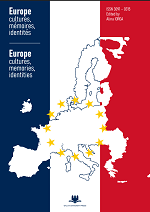
EUrope : cultures, mémoires, identités/ EUrope: cultures, memories, identities
Semiannual multidisciplinary journal
“Dunărea de Jos” University of Galați, Romania
EUrope : cultures, mémoires, identités/ EUrope: cultures, memories, identities, ISSN 3091-0315, is a semiannual multidisciplinary peer-reviewed journal devoted especially to the study of the dynamics of memories and of cultural identity representations which have shaped the spaces of experience, the horizons of expectation, and the sociocultural imaginaries in “Europe’s Europes” in the 20th and 21st centuries. EUrope… provides a special outlet to the analysis grounded in cultural memory studies, and particularly in contemporary theories of “agonistic memory”, considered as a “third way”, that of the research of an equilibrium between the contraries embodied in the two competitive paradigms which have disputed their hegemony in the European area, particularly since the end of the Cold War: the cosmopolitan/ transnational one, and the national(ist)/ antagonistic one. Though, the journal encourages submissions, if possible transdisciplinary, from a wide range of disciplines based in social sciences and humanities, concerning the general issues mentioned above: memory studies, nostalgia studies, historiography, philosophy of history and mnemohistory, social and political sciences, diaspora & migration studies, media studies, anthropology, cultural studies, literary studies, film, theater and performance studies, gender studies etc. Structured around thematic dossiers, but also including sections dedicated to varia and reviews, the two issues published per year will host original contributions in French and English, whose relevance and scientific accuracy will be evaluated by at least two independent anonymous referees, experts in the respective domains (double blind peer review).

